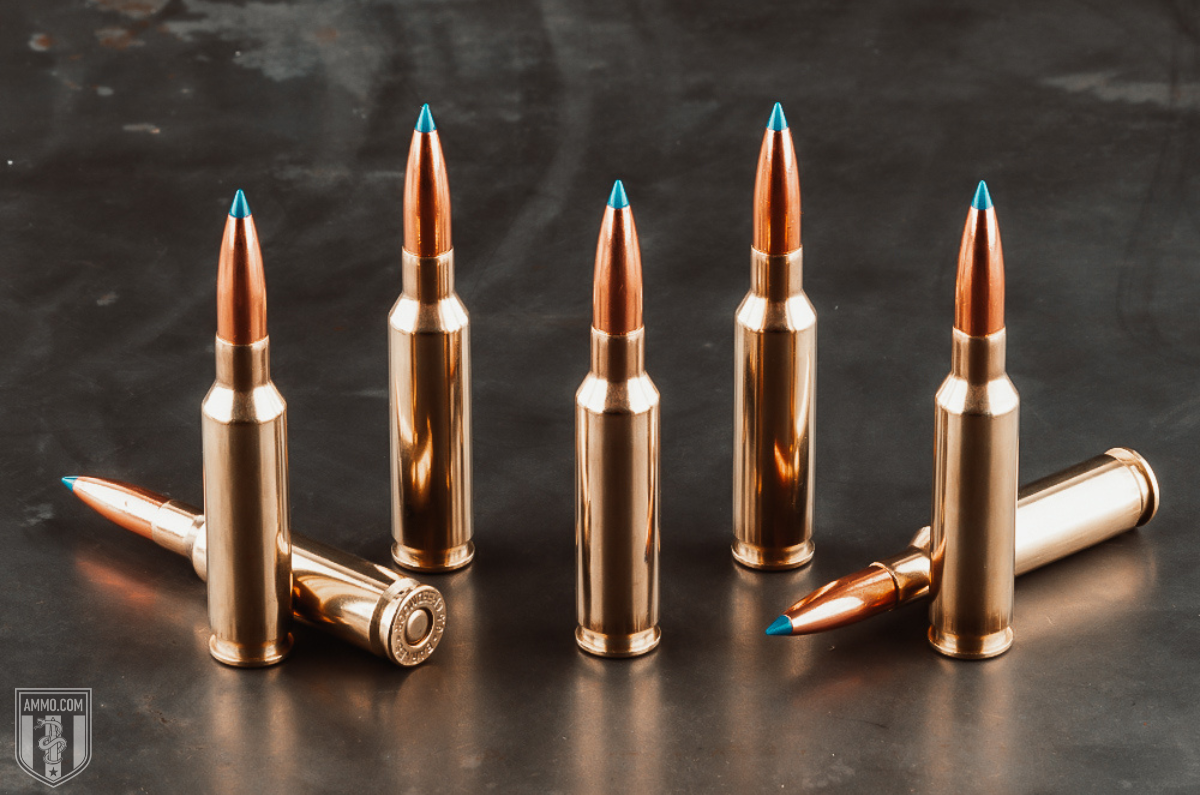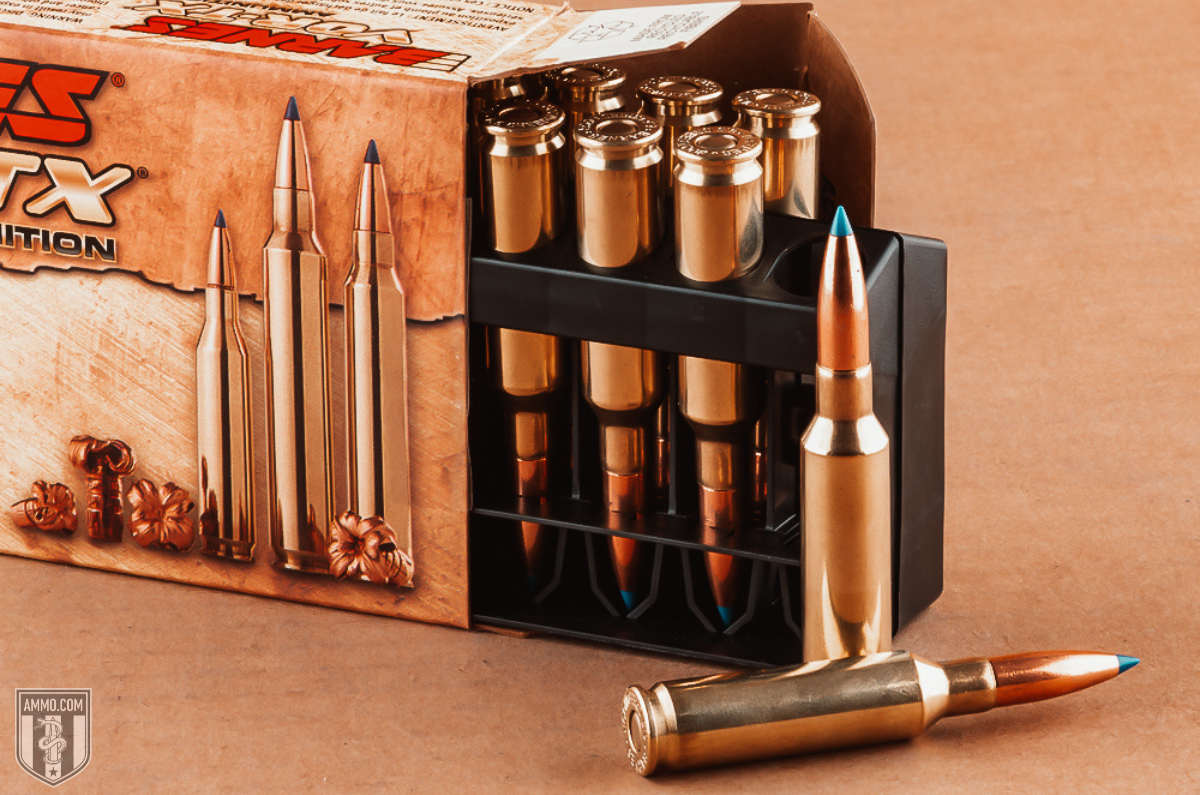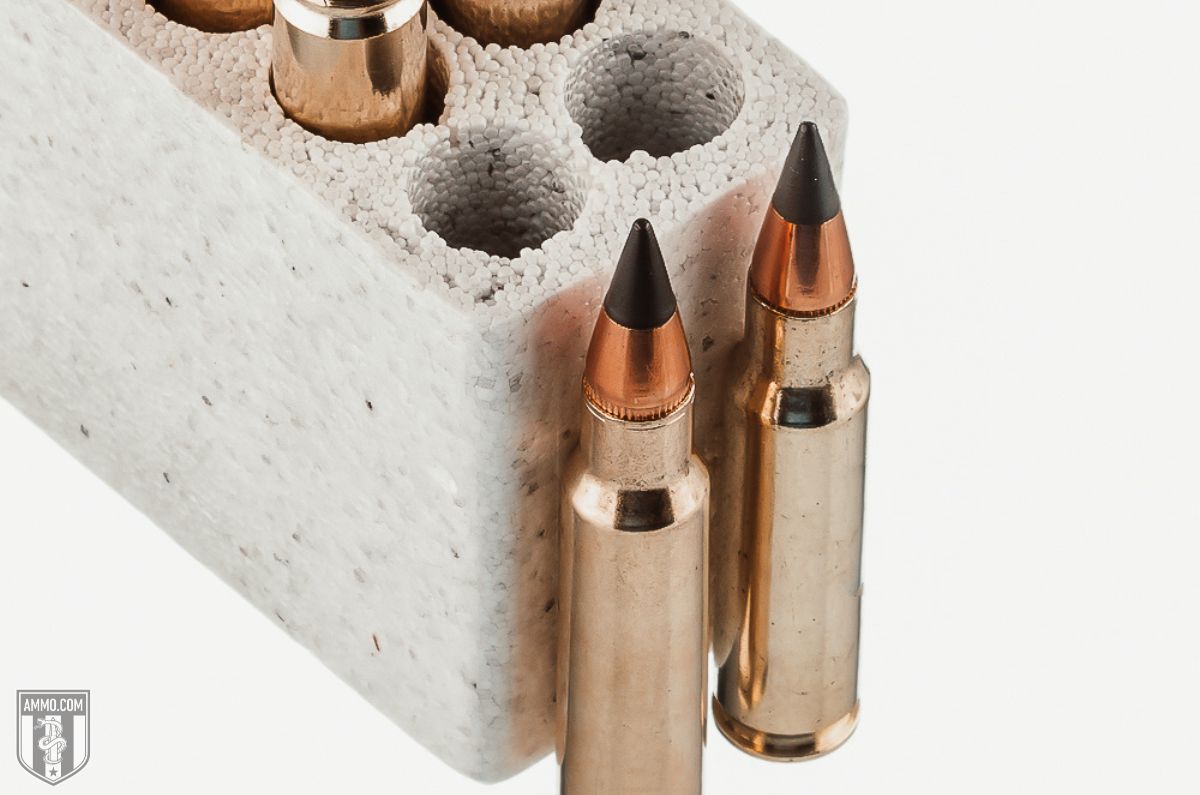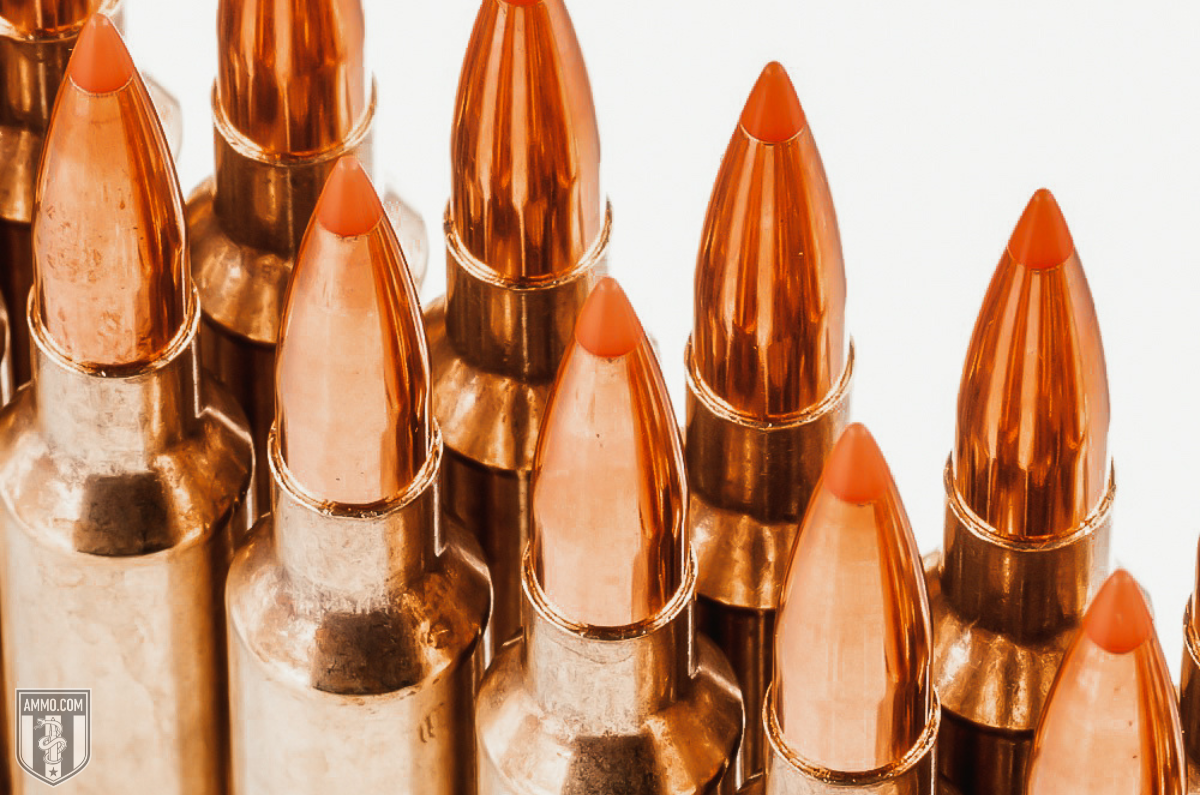6.8 SPC vs 6.5 Creedmoor: Long Range Advantage or Stopping Power?

The 6.8 Remington Special Purpose Cartridge (SPC) and 6.5 Creedmoor are two centerfire rifle rounds that were developed for drastically different purposes.
The 6.5 Creedmoor (or 6.5 CM for short) was initially developed for competitive long range shooting while the 6.8 SPC was developed by the U.S. military to increase the lethality of the AR-15 platform and replace the 5.56 NATO.
Although the 6.8 SPC is inferior to the 6.5 Creedmoor in virtually every ballistic category, it is a hard-hitting semi-auto round that is effective against whitetail and hogs at closer ranges.
This leads many new shooters to question if they should invest in a bolt-action 6.5 Creedmoor hunting rifle or if a 6.8 SPC is good enough for their area.
In this article, we will evaluate the 6.5 Creedmoor vs 6.8 SPC to help you understand the differences between the two and give you a clearer idea of which cartridge is best for your shooting needs.
What is the difference between 6.5 Creedmoor and 6.8 SPC?
The primary difference between the 6.5 Creedmoor and 6.8 SPC is their intended rifle and use. The 6.5 Creedmoor was designed for use in bolt-action rifles for long range shooting competitions while the 6.8 SPC was designed to increase the power level of the AR-15 carbine.
Cartridge Specs
When evaluating centerfire cartridges, it’s a good idea to analyze the cartridge specs to gain more knowledge of each.
Perhaps one of the biggest differences between the 6.8 SPC and 6.5 Creedmoor is how they came into being and their intended purpose.
The 6.8SPC is the elder of the two rifle cartridges being released in 2004 as part of a joint effort between Remington Arms, US Special Operations Command (USCOCOM), and the U.S. Army Marksmanship unit.
The round was developed by modifying the lesser known 30 Remington cartridge to fit into a standard M4 magazine and accept a 0.277” bullet diameter.
On the other hand, the 6.5 Creedmoor was released in 2007 in part due to a gripe session between legendary Service Rifle competitor, Dennis DeMille, and Dave Emary, the senior ballistician for Hornady Ammunition at the time.
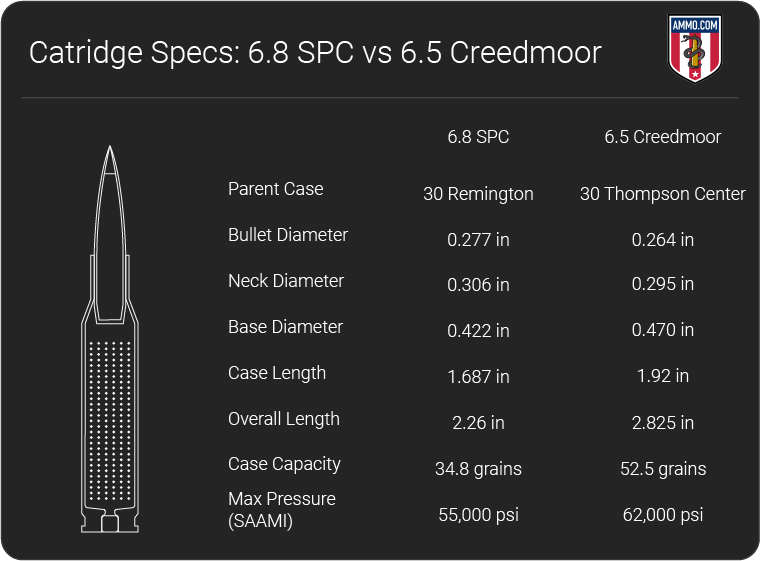
The round was developed by necking down a 30 Thompson Center case to accept a 6.5mm or 0.264” bullet diameter.
In terms of bullet weight, the 6.5 Creedmoor will generally fire heavier bullets. The 6.8 SPC can fire bullets between 85 and 140 grains, however the 110 and 115 grain bullets are the most popular. In contrast, the 6.5 Creedmoor can fire bullets between 95 and 153 grains with the 120, 130, and 140 grain options being the most prevalent.
Perhaps one of the most striking differences between these two rounds is the massive difference in size. The 6.5 Creedmoor simply towers over the 6.8 SPC in terms of case length and overall length. The 6.5 CM case measures 1.92” long with an overall length of 2.825” compared to 1.687” and 2.26” for the 6.8 SPC, respectively.
Although the 6.5 CM is the longer of the two cartridges, it is still short enough to fit into a short-action rifle. This is advantageous to the Creedmoor as short-action rifles are typically lighter and have a shorter bolt throw than standard action or long action rifles.
The 6.5 Creedmoor is a wider case as well with a base diameter of 0.470” compared to 0.422” for the 6.8 SPC.
These major differences in case dimensions means that the 6.5 Creedmoor will have a substantially higher case capacity than the 6.8 SPC. The SPC has a capacity of 34.8 gr but the 6.5 CM can hold a whopping 52.5 grains of powder. This means that the 6.5 Creedmoor can hold nearly 50% more powder than the 6.8SPC.
The final difference between these two rounds is the maximum chamber pressure each cartridge is rate for based on SAAMI specs. The 6.8 SPC can withstand 55,000 psi while the Creedmoor can handle considerably more at 62,000 psi.
What Is the Difference Between 6.8 SPC and 6.8 SPC II?
Although the 6.8 SPC seemed to be a potent and elegant answer to the 5.56 NATO terminal performance issue, there were some problems with its implementation.
When you’re looking to purchase a new upper receiver or barrel for 6.8, you might notice that the barrel is stamped as 6.8 SPC II. Many new shooters wonder what the difference between 6.8 SPC and 6.8 SPC II is, and the answer is in the design of the chamber.
The 6.8 SPC II chamber is designed to handle full-power 6.8mm SPC loads while the original 6.8 SPC chamber had a design flaw that could potentially cause pressure issues.
In their haste to bring the 6.8 SPC to market and capitalize the hype surrounding the new round, Remington botched the release of the cartridge with inaccurate chamber design specifications.
The original chamber designs called for 0.050” of free bore. However, when combined with a 1:10 twist rate barrel, pressure issues began to creep up. Initial reports claimed that the rounds were only around 200 psi above the maximum 55,000 psi pressure limits, but if the military learned anything from Vietnam, it was to follow specs to the letter.
Remington sought to remedy the higher pressure issue the best way they saw fit, which was to underload the ammo instead of fixing the free bore measurement. The resulting “light” 6.8 SPC ammo failed to meet expectations, and the US Army scrapped the project.
However, in all the excitement over the new 6.8 SPC, several civilian firearm manufactures clambered to release rifles chambered in the new cartridge before SAAMI had officially standardized the 6.8 SPC round. With numerous faulty rifles in circulation, the only action SAAMI could take was to sanction the round.
This is not to say that original 6.8 SPC rifles won’t function properly, but there is the potential for a critical pressure failure when using full power rounds.
The answer was the 6.8 SPC II.
The 6.8 SPC II added an additional 0.050” of free bore to the chamber and decreased the barrel twist rate to 1:11. This completely resolved the pressure issues experienced with the original design. All current rifles chambered in 6.8 SPC are technically chambered in 6.8 SPC II.
Although most factory loads will be loaded light (due to potential liability issues of original 6.8 SPC rifles still running loose in the wild), ammo for 6.8 SPC II rifles can be loaded to the full potential that the round was designed for.
To read more about the 6.8 SPC, check out these articles:
Recoil
The 6.8 SPC will generally have less recoil than the 6.5 Creedmoor.
Recoil is an important consideration when purchasing a new rifle as a round with heavy recoil will be more difficult to control and will slow your rate of follow up shots. The potential for flinching is also an issue for cartridges with heavy recoil.
Free Recoil is affected primarily by muzzle velocity (FPS), powder charge, bullet weight, and firearm weight.
A true “apples-to-apples” comparison is not possible with these rounds as they are fired from drastically different firearms. The 6.5 CM is primarily fired from bolt-action rifles while the 6.8 SPC is fired exclusively in the AR-15 (currently).
The test firearms for this comparison will be the Savage 110 High Country for the 6.5 Creedmoor weighing 8.5 pounds and the LWRC Six8-A5 for the 6.8 Remington SPC weighing 7.25 pounds.
The cartridges in question will be the Hornady 143 gr ELD-X Precision Hunter for the Creedmoor with a muzzle velocity of 2,700 fps and the Hornady 120 gr SST with a muzzle velocity of 2,460 fps for the 6.8.
Given these criteria, the 6.5 Creedmoor will have 14 ft-lbs of free recoil compared to 8 ft-lbs for the 6.8 SPC. That’s nearly a 2x difference!
It should be noted that most shooters will not have a problem controlling the recoil of either round. The 6.5 Creedmoor is considered very low recoil for the ballistic performance offers when compared to other higher recoil competition rounds like the 308 Winchester or the 300 Win Mag.
However, for recoil sensitive shooters, the 6.8 SPC is clearly has less recoil and will allow for faster follow up shots than a 6.5 Creedmoor.
Muzzle Velocity, Kinetic Energy, and Trajectory
If you frequent any shooting or hunting forums, you are likely aware that proponents of the 6.5 Creedmoor proclaim that the round is perfect for all your shooting needs (just ask them). On the other hand, 6.8 SPC supporters like to point out the rounds low recoil and amazing short range terminal ballistics.
To evaluate these claims, we will compare four of the most popular factory loads on the market and see how they stack up against each other!
For this comparison, we will analyze two popular options for each cartridge. For the 6.5 Creedmoor we will analyze the Hornady 143 gr ELD-X and the Barnes VOR-TX 127 gr LRX polymer tipped bullet and for the 6.8 SPC the Hornady 120 gr SST and Federal 115 gr Fusion soft point (SP) were selected.
The rounds will be compared out to 500 yards with one additional data point at 800 yards to evaluate long range trajectory.

In terms of muzzle velocity, the 6.5 Creedmoor was approximately 300-400 fps faster than all 6.8 SPC factory ammo selections. The 6.5 CM was also more efficient at conserving its velocity further downrange. This is clearly illustrated at the 800 yard line, where both loads for the 6.5 CM were well above the speed of sound (1,125 fps) while the 115 gr Fusion SP was subsonic at 1,112 fps while the 120 gr SST was transonic at 1,148 fps.
When it comes to kinetic energy, the 6.5 CM was the clear winner. The 143 gr ELD-X had the highest muzzle energy at 2,315 ft-lbs of force and the 127 gr LRX came in second at 2,250 ft-lbs. The 120 gr SST had the higher muzzle energy of the 6.8 SPC loads at 1,612 ft-lbs compared to 1,558 ft-lbs for the 115 gr Federal Fusion.
Just like with muzzle velocity, the 6.5 Creedmoor is more efficient at conserving its kinetic energy at range. For example, at 500 yards the 6.5 CM is still well above the 1,000-foot-pound threshold needed for ethically harvesting a whitetail while the 6.8 SPC rounds are at 619 ft-lbs and 565 ft-lbs for the 120 gr and 115 grain bullets, respectively.
The 6.5 Creedmoor is known for being incredibly flat shooting, and it earns that title when compared to the 6.8 SPC.
Out to 200 yards, all four rounds are roughly comparable, however at 300 yards the 6.5 Creedmoor starts to pull away. By 400 yards the 6.5 and 6.8 bullets are separated by over a foot difference in bullet drop.
At the 500 yard marker the two 6.5 CM bullets have experienced -53” and -54” of bullet drop, while the two 6.8 rounds have -78” and -80” of bullet drop for the 120 gr and 115 gr loads, respectively. The difference is only exacerbated at 800 yards, where the 127 gr LRX has -188” and 143 gr ELD-X has -181” of bullet drop. Compare that to -290” for the 120 gr SST and -300” of bullet drop for the Fusion SP 6.8 SPC rounds.
Looking at this ballistic data, what conclusions can we draw?
The 6.5 Creedmoor ballistics clearly show how the round was designed long distance target shooting. The 6.5 has a very flat trajectory and uses projectiles that are effective at retaining their kinetic energy and velocity at distance. This gives the 6.5 Creedmoor a longer effective range than the 6.8 SPC.
On the other hand, the 6.8 SPC seems to excel at shorter ranges, as it has nearly 40% more kinetic energy than a 5.56 NATO round but lacks the long-range capabilities of the 6.5 Creedmoor. However, the 6.8 SPC has the added benefit of being fired from the semi-auto AR-15 while the 6.5 CM is typically fired from a bolt-action rifle. This means that follow-up shots will generally be faster from a 6.8.
Ballistic Coefficient and Sectional Density
The 6.5 Creedmoor will generally have a higher ballistic coefficient and sectional density than comparable 6.8 SPC factory ammo.
Ballistic coefficient (BC) is a measure of how aerodynamic a bullet is and how well it will resist wind drift. Sectional density (SD) is a way to evaluate the penetration ability of a bullet based on its external dimensions, design, and weight.
The 6.5mm bullet design is known for being incredibly aerodynamic and sleek. This was one of the main reasons why Hornady decided on a 6.5mm bullet for the Creedmoor.
To be fair, the 6.8mm bullets used by the SPC are very aerodynamic as well. However, due to the overall length limitations of the AR-15 chamber, the 0.277” diameter bullets used by the 6.8 SPC are not as sleek as they potentially could be, which negatively affects their BC.
For the 6.5 Creedmoor, the 143 gr ELD-X has the highest BC of 0.625 while the 127 gr LRX measures in at a respectable 0.468. The 6.8 bullets analyzed have a lower BC, as the 120 gr SST has a BC of 0.40 while the 115gr Fusion has a BC of 0.378.
For sectional density, the 6.5mm bullets will often have deeper penetration as they focus their kinetic energy over a smaller cross-sectional area. The 143 grain bullet for the 6.5 CM has the highest SD of 0.293 while the 120 gr SST for the 6.8 had a SD of 0.223.
To summarize, the 6.5 CM will be more resistant to wind drift thanks to its higher BC values. This is ideal when shooting at longer ranges where wind drift can seriously affect the flight path of a bullet.
On the other hand, even though the 6.5 generally has higher SD values than the 6.8, both rounds have more than enough penetration capability for large game like whitetail, antelope, hogs, and pronghorn within their effective ranges.
Hunting
When it comes to medium-sized game hunting, the 6.5 Creedmoor and 6.8 SPC are both excellent options within their effective ranges.
There is little question that the 6.5 Creedmoor offers deer hunters a considerably longer effective range. Most shooters would agree that the 6.8 has about a 200 yard effective range for whitetail, while the 6.5 Creedmoor can have triple that with proper hunting ammo.
Make sure you are stocked full of Hornady 6.5 Creedmoor ammo for hunting season this fall!
Obviously, this is a big selling point for the Creedmoor, however many hunters in the New England, the Midwest, and Pacific Northwest often find that their hunting conditions don’t require such a long range round. When hunting in thick brush or densely wooded areas for whitetail, most shots will be taken within 150 yards or less. This means that there is little benefit to upgrading to a 6.5.
Furthermore, the 6.8 SPC was developed to function in a shorter barrel length like those used in the M4 carbine. Typically, shorter barrels lead to losses in muzzle velocity, however ballistic testing suggests that very little muzzle velocity is gained by firing the 6.8 in anything longer than a 16 inch-barrel.
This means that a 6.8 SPC carbine with a 16 inch-barrel can be an incredibly handy hunting rifle that is very lightweight and is capable of semi-auto fire. This is one reason why the 6.8 SPC has become extremely popular with hog hunters in southern states.
However, if you plan on hunting mule deer or pronghorn on the Great Plains, then the 6.5 Creedmoor clearly makes the better choice. The superior 6.5 Creedmoor ballistics cannot be ignored when taking a long range shot, as you need to ensure that you have enough kinetic energy to ethically harvest the animal at range.
For varmint hunting, both cartridges have lower bullet weight options available. Most varmint hunters would agree that the 6.5 and 6.8 are best suited for coyote-sized varmints. There’s nothing saying you can’t use a 6.5 or a 6.8 for smaller game animals like prairie dogs and woodchucks, but a smaller cartridge like a 223 Remington or 22-250 is typically preferred for these varmints.
For big game like elk, the 6.5 Creedmoor is the only option as the 6.8 SPC lacks the kinetic energy needed to take down these larger game animals. It’s important to note that a 6.5 CM can only be used on elk at a maximum range of around 200-300 yards depending on your load. This is why most elk hunters prefer a more powerful cartridge like the 28 Nosler or 300 Win Mag.
Ammo and Rifle Cost/Availability
The 6.5 Creedmoor cannot be beat when it comes to ammo availability and rifle options as it has become the most popular 6.5mm caliber cartridge on the market. Additionally, the botched launch of the 6.8 SPC gave some ammo and rifle manufacturers pause which is one reason for its less than stellar commercial success so far.
The popularity of the 6.5 CM and ammo availability cannot be understated, as there is no worse feeling then going out to the range and not having ammo available to shoot with.
The Creedmoor offers shooters an extreme amount of versatility, as there are lighter 95 grain bullets loaded for varmints and heavier projectiles that can easily take down whitetail or your next long range precision rifle competition.
Virtually every ammo manufacture like Hornady, Winchester, Remington, Norma, Berger, Barnes, Federal and Browning has some version of 6.5 Creedmoor hunting ammo available. Although there are considerably more varieties of 6.5 CM factory ammo available, there are still plenty of options for 6.8 SPC from Winchester, Remington, Hornady, Federal, Nosler, and Silver State Armory.
The 6.5 CM and 6.8 SPC are essentially equivalent in terms of ammo cost. Generally, less expensive practice ammo will go for around $1.20/round and premium hunting ammo costing between $2-3.50/round for both cartridges.
Speaking of cost, make sure to check out our stock of Hornady 6.5 Creedmoor for more options and price comparison.
When it comes to rifle options, the 6.5 Creedmoor when it comes to bolt-action rifles while the 6.8 SPC has the corner on the semi-automatic market cornered.
Entry level 6.5 CM bolt-action rifles like the Ruger American and Savage Axis can be had for under $500, while more expensive hunting rifles like a Browning X-Bolt, Savage 110, and Winchester Model 70 can be had for a bit more.
For PRS competitive shooters, the Ruger Precision Rifle and Savage 110 Precision are two out of the box long range rifles ready for the 1,000 yard line. Semi-automatic options for the 6.5 CM are also available in the FN SCAR, Springfield Armory M1A, and AR-10 pattern rifles.
As the 6.8 SPC was built for the AR-15 platform, it means that any AR on the market is a potential host for the caliber. All that is required for a conversion is a new barrel, bolt, and magazines. If you’re in the market for an upper receiver or a completed rifle, there are plenty of configurations available from LWRC, Wilson Combat, Stag Arms, Rock River Arms, and Daniel Defense.
Currently the AR-15 is the only host for the 6.8 SPC, however in the past the Bushmaster ACR and the Ruger Mini 14 were available in the caliber. Ruger discontinued production of their 6.8 version of the Mini 14 in 2012 while Bushmaster ceased production of the ACR in 2020. Both rifles are incredibly rare and expensive if you can find one on the secondary market.
There are currently no bolt-action or single shot rifles available for 6.8 SPC.
Reloading
Reloading is one method shooters use to reduce their overall cost per round and increase the consistency of their ammo to sub-MOA levels. Furthermore, handloads can be tailored to your rifle to meet your specific shooting needs.
Bullets for 6.5mm are relatively easy to come by as this bullet diameter is also fired in the 6.5 Grendel, 6.5x55 Swiss, 264 Win Mag, 260 Remington, 6.5-.284 Norma, and 6.5 PRC. Furthermore, virtually every bullet manufacturer, like Hornady, Federal, Barnes, Nosler, and Berger, have multiple bullet varieties for the 6.5.
Likewise, the 0.277” bullets fired by the 6.8 SPC are extremely popular as they are also used in the 270 Winchester, 270 WSM, 270 Weatherby Magnum, and the new 277 SIG Fury.
This means that if you make handloads for one of these cartridges, you’ll be able to stockpile bullets for any of the others that share the same bullet diameter.
Brass is relatively easy to come by for both cartridges, but the 6.5 Creedmoor will have a slight edge in availability thanks to its widespread popularity.
Making your own handloads for the 6.8 SPC also means that you will be able to unleash the full potential of the cartridge provided your firearm has a SPC II chamber. For the 6.5 Creedmoor, reloading allows shooters to achieve the utmost levels of precision, consistency, and accuracy that the 6.5 can offer.
Final Shots: 6.5 Creedmoor vs 6.8 SPC
The 6.5 Creedmoor and 6.8 SPC are two rifle cartridges with extremely different intended purposes.
The 6.8 Remington SPC makes for an excellent self-defense and short range hunting round designed for the AR-15 rifle. As a true intermediate cartridge, the 6.8 offers shooters impressive short range ballistics that are excellent for hunting in thick brush or engaging close range targets.
The 6.5 Creedmoor is one of the most successful long-range cartridges developed in the 21st Century. It has low recoil for the power that it offers with an incredibly flat trajectory. Although initially developed for shooting competitions, the 6.5 Creedmoor has successfully transitioned into the hunting world and makes for a potent long range deer hunting cartridge.
Deciding between the 6.8 SPC vs 6.5 Creedmoor depends primarily on the distances you expect to shoot. If you plan on shooting past 300 yards, then the 6.5 Creedmoor is clearly the obvious choice. However, if you plan to take all your shots within 300 yards and want a cartridge for both home defense and hunting, then the 6.8 SPC deserves a look.
No matter which cartridge you choose, make sure you stock up on ammunition here at Ammo.com and I’ll see you on the range!
Ammo Comparisons
- .308 vs 5.56
- 6.5 Creedmoor vs .308
- .300 Blackout vs .308
- .300 Win Mag vs .308
- .243 vs .308
- .308 vs .30-06
- 7mm-08 vs .308
- .270 vs .308
- 7.62x39 vs .308
- .223 vs .308
- .338 Lapua vs .308
- .380 ACP vs 9mm
- .223 vs 5.56
- .300 Blackout vs 5.56
- 9mm vs 45 ACP
- 9mm vs 40 S&W
- .357 SIG vs 9mm
- 10mm vs 9mm
- 9mm vs 9mm Luger
- .243 vs .270
- .300 Win Mag vs .30-06
- .270 vs .30-06
- .40 vs .45
- 38 Special vs 357
- 9mm vs 40 vs 45
- 5.56 vs 7.62x39
- 338 Lapua vs .30-06
- .30-30 vs .30-06
- 300 PRC vs 338 Lapua
- .30-06 vs 7mm
- 300 Win Mag vs 338 Lapua
- 300 PRC vs 300 Win Mag
- 300 WSM vs 300 Win Mag
- 338 Win Mag vs 338 Lapua
- 12 Gauge vs 20 Gauge
- 10mm vs 357 Mag
- .30-30 vs 7.62x39
- 224 Valkyrie vs 22-250
- 17 HMR vs 22 Mag
- 7.62x39 vs .300 Blackout
- 45 ACP vs 45 Auto
- 45-70 vs 30-30
- 300 Blackout vs 223
- 357 Magnum vs 9mm
- 350 Legend vs 300 Blackout
- 224 Valkyrie vs 223
- 45 ACP vs 38 Super
- 6.5 Grendel vs .308
- 17 HMR vs 22 LR
- 10 Gauge vs 12 Gauge
- 22-250 vs 223
- 45 Colt vs 45 ACP
- 350 Legend vs 30-30
- 5.7x28 vs 223
- 5.7 vs 9mm
- 5.56 vs 5.7
- 22 vs 9mm
- Buckshot vs Birdshot
- 450 Bushmaster vs 308
- 450 Bushmaster vs 223
- Buckshot vs Slug
- 6.5 Grendel vs 5.56 vs 223
- 6mm ARC vs 6.5 Grendel
- 44 vs 45
- 458 SOCOM vs 5.56
- 357 vs 44
- 32 ACP vs 380
- 300 Win Mag vs 338 Win Mag vs 338 Lapua Mag
- 450 Bushmaster vs 458 SOCOM vs 50 Beowulf
- 6mm Creedmoor vs 6.5 Creedmoor
- TMJ vs FMJ
- 44 Special Vs 44 Magnum
- 45 90 vs 45 70
- 6.8 Western vs 6.8 SPC
- 50 Beowulf vs 50 BMG
- 26 Nosler vs 6.5 PRC
- 28 Gauge vs 410
- 6.8 SPC vs 5.56
- 6.8 SPC vs 6.5 Grendel
- 6.8 Western vs 7mm Rem Mag vs .28 Nosler
- 6.8 Western vs 6.5 Creedmoor
- 22 Hornet vs 223
- 6.8 Western vs 6.5 PRC
- .410 vs 12 Gauge
- .410 vs 20 Gauge
- 22 LR vs 22 Mag
- 6mm ARC vs 243
- 7mm-08 vs 270
- 243 vs 6.5 Creedmoor
- Nickel vs Brass Casing
- 204 Ruger vs 223
- 50 Beowulf vs 5.56
- 260 Remington vs 6.5 Creedmoor
- 6mm Remington vs 243
- 28 Nosler vs 300 PRC
- 50 Beowulf vs 50 AE
- 22 Nosler vs 22-250
- 450 Marlin vs 45-70
- 300 Win Mag vs 300 Norma
- 458 SOCOM vs 300 Blackout
- 38-55 vs 45-70
- 22 Hornet vs 22 LR
- 300 Norma vs 338 Lapua
- 338 Lapua vs 50 BMG
- 28 Nosler vs 300 Win Mag
- 28 Nosler vs 6.5 Creedmoor
- 204 vs 22-250
- 458 SOCOM vs 45 70
- 44 40 vs 45 70
- 6.8 SPC vs 6.5 Creedmoor
- 450 Bushmaster vs 30-06
- 7mm Rem Mag vs 300 Win Mag
- 30 Carbine vs 223
- 25-06 vs 30-06
- 26 Nosler vs 28 Nosler
- 16ga vs 12ga
- 30 06 vs 7.62 x54R
- 9mm Makarov vs 9mm Luger
- 350 Legend vs 223
- 30 Carbine vs 5.56
- 6.5x55 vs 6.5 Creedmoor
- 6.5 Creedmoor vs 270 vs 25-06
- M193 vs M855
- 450 Bushmaster vs 458 SOCOM
- 6.5 Grendel vs 6.5 Creedmoor
- 350 Legend vs 5.56
- .277 Fury vs 6.8 SPC
- 277 Fury vs 300 Win Mag
- 10mm vs .45 ACP
- 277 Fury vs 223
- 6.8 SPC vs 300 Blackout
- 6.5 PRC vs 6.5 Creedmoor
- 277 Fury vs 308
- 277 Fury vs 6.5 Creedmoor
- 350 Legend vs 450 Bushmaster
- 277 Fury Vs 5.56 NATO
- 10mm vs 40S&W
- 32 ACP vs 9mm
- 32 Special vs 9mm
- 8.6 Blackout vs 300 Blackout
- 30 Super Carry vs. 9mm
- 5.56 vs 9mm
- .50 Action Express vs 9mm
- 7.62x25 vs. 9mm
- 10mm vs 44 Magnum
- 300 Blackout vs 300 Win Mag
- 6.5 Grendel vs 300 Blackout
- 460 Rowland vs 10mm
- 300 RUM vs 300 PRC
- 300 Norma vs 300 PRC
- 45 GAP vs 45 ACP
- 7mm PRC vs 300 Win Mag
- 300 PRC vs 6.5 Creedmoor
- 300 PRC vs 308
- 357 SIG vs 357 Mag
- 7.62x39 vs 7.62x51
- 243 Win vs 223 Rem
- 30 Nosler vs 300 PRC
- 6.5 Creedmoor vs. 30-06 Springfield
- 450 S&W vs. 44 Magnum
- 6.5 Creedmoor vs. 300 Win Mag
- 454 Cassull vs. 45-70 Govt
- 454 Cassull vs. 44 Mag
- 7.62x54r vs. 308 Winchester
- 22 ARC vs. 223 Rem
- Subsonic vs. Supersonic Ammo

